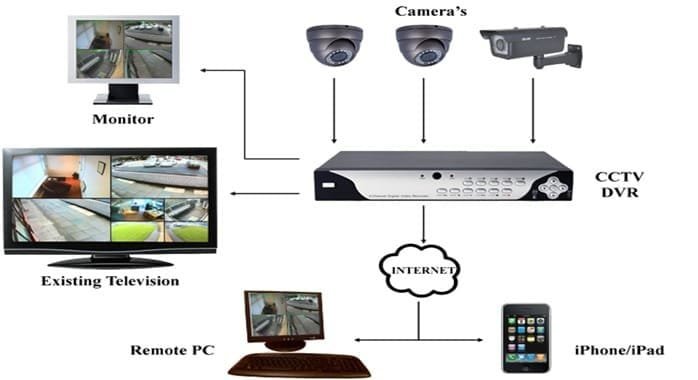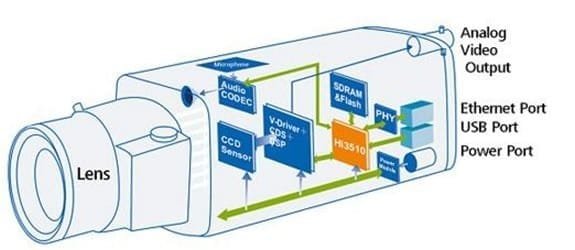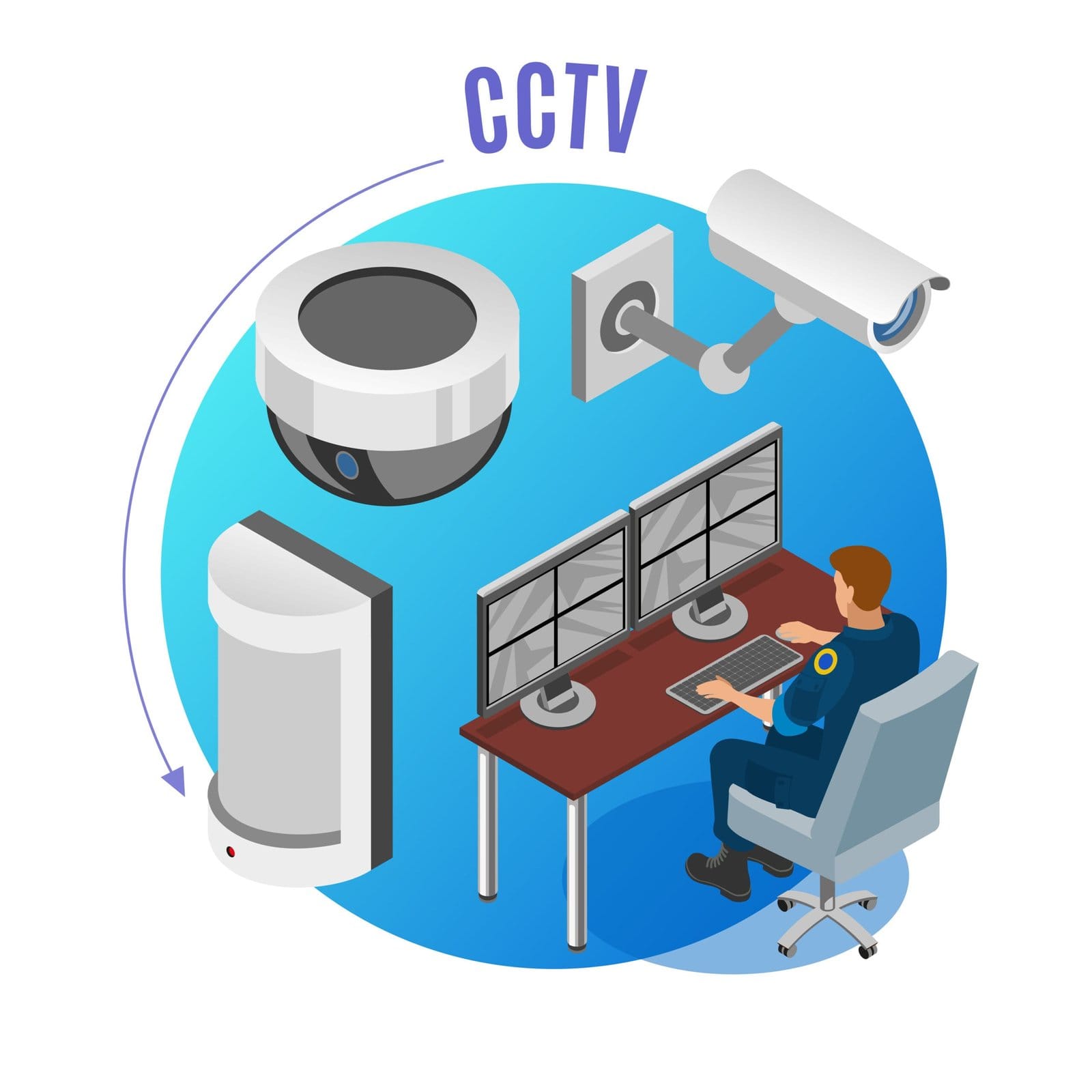I. Introduction: What is CCTV?
- CCTV stands for Closed Circuit Television, which is a system where all of its circuits are closed and directly connected. This is different from broadcast television, where signals are accessed through special receiving equipment designed to receive signals over the airways.

Table of Contents

2. CCTV has long been a key player in the security industry, but it’s now being used more widely for monitoring and control purposes. As a result, CCTV is proving to be a valuable tool for both traditional surveillance methods and more specialized applications. As management systems and networking technologies continue to advance, the use of CCTV is expected to increase even further.
II. Importance and Advantages of CCTV in Modern Security and Surveillance:
It is important to acknowledge the significant contribution of CCTV in improving security measures and keeping the public safe. Let’s explore how it has become a crucial component of both residential and commercial security systems.
Advantages:
When stealing, you can be caught.
III. The Evolution of CCTV Technology :

- First used by Siemens in 1942 to test V2 rocket launch by Germany (only Monitoring).
- First recorded on VHS tapes in the 1970s in b/w.
- Low light & Color Video recording was developed in the 1980s as Sensor Chips where used in Cameras.
- Digital Recording evolved in the 1990s along with the development of computer technology.
- Network video surveillance and video analytics is the latest advancement in CCTV technology.
IV. Image Sensor:
The image sensor is a chip in the camera which detects and conveys information that constitutes an image.

- Heart of the Camera
- It converts light into electrical signals (photons to electrons)
- There are two types of Image sensors, CCD and CMOS, the difference is in the way they convert images to information
V. What are CCTV Image Sensors:
1. Charge-Coupled Device (CCD)

- CCD sensor captures light on the small photo-sites (pixels) on their surface and converts to electrical charge one row at a time
- This signal is then amplified and converted to numbers using an A/D converter outside the sensor.
- CCD Sensors are more expensive.
- HD Technology uses megapixel sensors.
- Consume more power (as more circuitry is needed outside the sensor).
- Analog Cameras use CCD sensors.
2. Complimentary Metal-Oxide Semiconductor (CMOS)

- CMOS sensor differs from CCD in the way that the amplification takes place at the photo site using transistors.
- Every CMOS pixel contains conversion electronics i.e. amplifiers and A/D-converters inside the sensor.
- Consume less power.
- Each pixel is read individually.
- CMOS Megapixel and Multi-Megapixel sensors are widely available and less expensive.
- Digital/IP cameras may have either CCD or CMOS sensors.
VI. Image Sensor Format:
Image sensors come in different formats (sizes). The format is determined by the diameter of the sensor measured in “inches” such as 1/4, 1/3, 1/2, 2/3, and 1 inch.

Sensor sizes must be considered in relation to the lens selected because lenses are designed for specific sensors. The common sizes used today are 1/3” and 1/2” sensors.

- The common sizes used today are 1/3” and 1/2” sensors.
- Large Lens offers greater Depth of Field and vice versa.
VII. Lens:
A device that collects light from an environment, narrowly focusing it onto Image Sensor.

- The lens is the Eye of the camera
- The lens gathers light and focuses on the image sensor.
- It performs two main functions.
- It controls the amount of light reaching the sensor (Function of Iris).
- Determines the scene that is shown on the monitor (Function of Focal Length).
- Lens are also categorized according to Format size (just like image sensors) e.g. 1/4, 1/3, 1/2, 2/3, and 1 inch.
- The lens must make an image circle large enough to cover the sensor, if not the corners of the image will be black.
- It is possible to use a lens designed for a larger sensor on a smaller sensor but not the opposite.
VIII.Focal Length
Focal length is the distance between the centre of the lens and the Focal Point/Image Sensor.

- The point at which the image sensor is positioned is called the focal point.
- Focal length is measured in millimetres (mm).
- Focal Length determines Field of View & Depth of Field.
- Short Focal Length = Wide Field of View & Deeper Depth of Field.
- Long Focal Length = Narrow View & Shallow Depth of Field.
IX. Resolution:
Resolution is the capacity of the sensor to show images of fine quality.

- For Analog systems, the resolution is measured in Television Lines (TVLs).
- TVL is Horizontal Resolution (Vertical Lines).
- Higher the number of TV lines higher the resolution
- HD Resolution is measured in Vertical Resolution (Horizontal Lines)
- For Digital systems, the resolution is measured in Pixels
- A pixel is the smallest unit of the digital image
- Digital Resolution is expressed as the number of pixels in Width x Height Format ( e.g. 1600 x 1200).
- More Pixels ====>Higher Resolution====>Better Clarity of picture.
X. Basic Concepts of What is CCTV?:
Purpose of CCTV
- Monitor: Monitoring an Area, a Person Should Appear at Least 5% of Screen Height.
- Detect: Detection of Intruders Into an Area, Persons Should be at least 10% of Screen Height.
- Observe: Observation of details such as clothing, Persons should be 25% of Screen Height.
- Recognize: Recognition of a Known Individual, Persons Should be 50% of Screen Height.
- Identify: Identify an Unknown Person, Present an Image at 120% (knees to head).

XI. Camera:
A camera is a system which collects reflected light, converts it into an image and sends it in the form of electrical signals.
All cameras are composed of 3 basic parts :
- Image Sensor: Converts light into electrical signals
- Lens: Gathers light reflected from the subject
- Image Processing Circuitry: Organizes, Optimizes & Transmits Signals
Types of CCTV Cameras:
CCTV Cameras are classified in different ways. For convenience they can be categorized mainly as follows:-

Based on Image Type & Function:
- Monochrome: Only one colour, High Resolution in Low light, Less Expensive
- Colour: Better representation of the scene, Good for identification & prosecution
- Day/Night: Color in Day time and monochrome at night, NO Infra-Red LEDs
- IR Camera: A camera with IR LEDs, can function in total darkness
- Wireless Camera: Have Antennae, no wires, and work on Wi-Fi technology (Radio Waves).
Based on Shape and Usage:

- Discreet / Spy Camera
- Board Camera
- Dome Camera
- Bullet Camera
- Box Camera
- Zoom Camera
- NPR Camera PTZ / Speed Dome Camera
Home CCTV Systems:
Describe how CCTV is now accessible for residential use, contributing to better home security and peace of mind for homeowners.
1. Commercial and Business CCTV Systems: Discuss the specific needs and applications of CCTV in businesses such as retail stores, offices, and warehouses, where security is a top priority.
2. Mobile and Wireless CCTV Solutions: Explain the emergence of mobile and wireless CCTV systems, which offer flexibility and ease of installation in temporary locations or remote areas.
XII. Factors to Consider When Setting Up CCTV:

- Legal and ethical considerations: Highlight the importance of following privacy laws and ethical guidelines when installing a CCTV system, in order to avoid violating people’s rights to privacy.
- Selecting the right camera type and features for specific needs: Provide guidance on selecting appropriate cameras and features based on intended surveillance objectives and the environment in which they will be installed.
- Strategically Placing Cameras for Optimum Coverage: Explain the importance of strategic camera placement to maximize the coverage and effectiveness of a CCTV system.
XIII. Maintenance and Management of CCTV Systems:
1. Routine Inspection and Cleaning:
Inspect your CCTV cameras regularly to ensure they are in top working condition. Check for any physical damage, loose connections or signs of tampering. Additionally, clean the camera lens and housing to remove dust, dirt and debris, as these can affect image quality and motion detection capabilities.
2. Verify CCTV Camera Angles and Focus:
Make sure that your CCTV cameras are positioned correctly to effectively cover the desired areas. Check camera angles and adjust them if necessary to avoid blind spots. Verify the focus of each camera to guarantee clear and crisp footage.
3. Test CCTV Camera Functions:
Make sure that your CCTV cameras are positioned correctly to effectively cover the desired areas. Check camera angles and adjust them if necessary to avoid blind spots. Verify the focus of each camera to guarantee clear and crisp footage.
4. Review Storage and Backup Systems:
Measure the storage capacity of your recording devices (DVR/NVR) and verify they are working correctly. Regularly back up recorded footage to an external storage device or cloud to prevent data loss in the event of system failure or tampering.
5. Check Cables and Power Supply:
Regularly inspect all cables and connections to make sure they are secure and not damaged. Faulty cables or power supply problems can interrupt the camera feed and cause gaps in surveillance coverage.
6. Firmware and Software Updates
To keep your CCTV system up-to-date with the latest features, improvements, and security patches, regularly check for firmware and software updates provided by the camera manufacturer or the CCTV system’s vendor. These updates often address potential vulnerabilities and enhance overall system performance.
7. Storage and Data Backup
The recorded footage from CCTV cameras generates significant amounts of data, and proper storage and data backup procedures are essential to preserve this valuable information. Invest in a reliable storage solution that can handle the data volume and ensure that backups are regularly scheduled to prevent data loss in the event of a system failure.
8. Incident Response and Reporting
Develop a clear incident response plan and reporting mechanism for any security breaches or incidents captured by the CCTV system. This plan should outline the steps to be taken in case of a security event and how the relevant authorities should be informed.
9. Employee Training
Ensure that personnel responsible for managing the CCTV system receive adequate training on its operation, maintenance, and troubleshooting. Well-trained staff can effectively handle any issues that may arise and make the most of the system’s capabilities.
10. User Access and Permissions
Properly manage user access and permissions to the CCTV system. Limit access to authorized personnel only and assign different levels of permissions based on their roles. This practice enhances security and reduces the risk of unauthorized access or tampering with critical settings.
11. Compliance with Legal Requirements
Stay informed about the legal requirements and regulations related to CCTV surveillance in your region. Ensure that your CCTV system adheres to these guidelines to avoid any legal complications.
By focusing on the maintenance and management of your CCTV system, you can maximize its efficiency, longevity, and overall performance. A well-maintained CCTV system not only enhances security but also provides peace of mind, knowing that your property and assets are well-protected round-the-clock.
XIV. Future trends in CCTV technology:

- AI-Assisted Surveillance: Unleashing the Potential of Smart CCTV
AI is changing the surveillance market, allowing CCTV cameras to do much more than just record footage. We’ll look at how artificial intelligence-powered analytics can detect suspicious activity, recognize faces, and even predict potential security concerns. Learn how these innovations improve the capabilities of CCTV systems and help secure a safer future. - Panoramic CCTV Solution with 360-Degree Vision: 360-degree panoramic CCTV systems are replacing traditional fixed-angle cameras. Discover the benefits of these omnidirectional cameras that reduce blind spots and provide complete coverage. We’ll also look at how they can be used in a variety of contexts, from homes to businesses.
- Ultra-High Definition: The Dawn of 4K and Beyond in CCT Witness the leap in image clarity with Ultra-High Definition (UHD) and 4K CCTV cameras. Discover the benefits of crystal-clear resolution in identifying details and obtaining vital evidence. We will also discuss potential applications in areas such as facial recognition and license plate reading.
- Cloud-Based Surveillance: The Future of CCTV Data Management Cloud is changing the way CCTV footage is stored and accessed. Discover the benefits of cloud-based monitoring, such as remote access, scalability, and seamless integration with other smart devices. Learn how this technology is shaping the future of CCTV data management.
- IoT Integration: Merging CCTV with the Internet of Things The Internet of Things (IoT) is connecting devices like never before, and CCTV is no exception. We’ll explore how IoT integration allows CCTV systems to work in conjunction with other smart devices, enhancing automation and optimizing security measures.
XV. Conclusion of What is CCTV?:
In conclusion, understanding what CCTV is and how it functions is essential in appreciating its significance in today’s security landscape. CCTV, short for Closed-Circuit Television, empowers individuals, businesses, and authorities to monitor specific areas and gather valuable video footage. With its ability to deter crime, enhance security, and provide critical evidence in investigations, CCTV has become a crucial tool in safeguarding people, property, and public spaces.
- Recapitulating the Importance and Benefits of CCTV: Summarize the main points of What is CCTV and discussed them throughout the blog post, emphasizing the importance of CCTV in contemporary security practices.
- Promotion for responsible use of CCTV technology and awareness: Advocating for the responsible deployment of CCTV systems and the need to balance security with privacy considerations.
- Final Thoughts on the Role of CCTV in a Safer Society: Conclude with your perspective on how CCTV contributes to creating a more secure environment for all.
- Understanding what is CCTV and its applications can greatly enhance security and surveillance practices. By implementing the right type of cameras, proper placement, and adhering to legal requirements, CCTV can serve as a valuable asset in safeguarding both personal and commercial properties.
- As technology advances, CCTV systems will continue to evolve, offering even more sophisticated features and functionalities. However, it is essential to strike a balance between the benefits of CCTV and the concerns related to privacy. By adhering to ethical practices, following regulatory guidelines, and implementing responsible surveillance, CCTV can truly fulfil its role as a potent ally in maintaining a safe and secure environment for everyone.
- In a world where security is of paramount importance, understanding and embracing the potential of CCTV can undoubtedly contribute to a safer and more protected society. Whether in commercial establishments, public places, or residential areas, the presence of CCTV instils confidence and acts as a constant watchful eye, deterring wrongdoers and ensuring a greater sense of safety for all.

